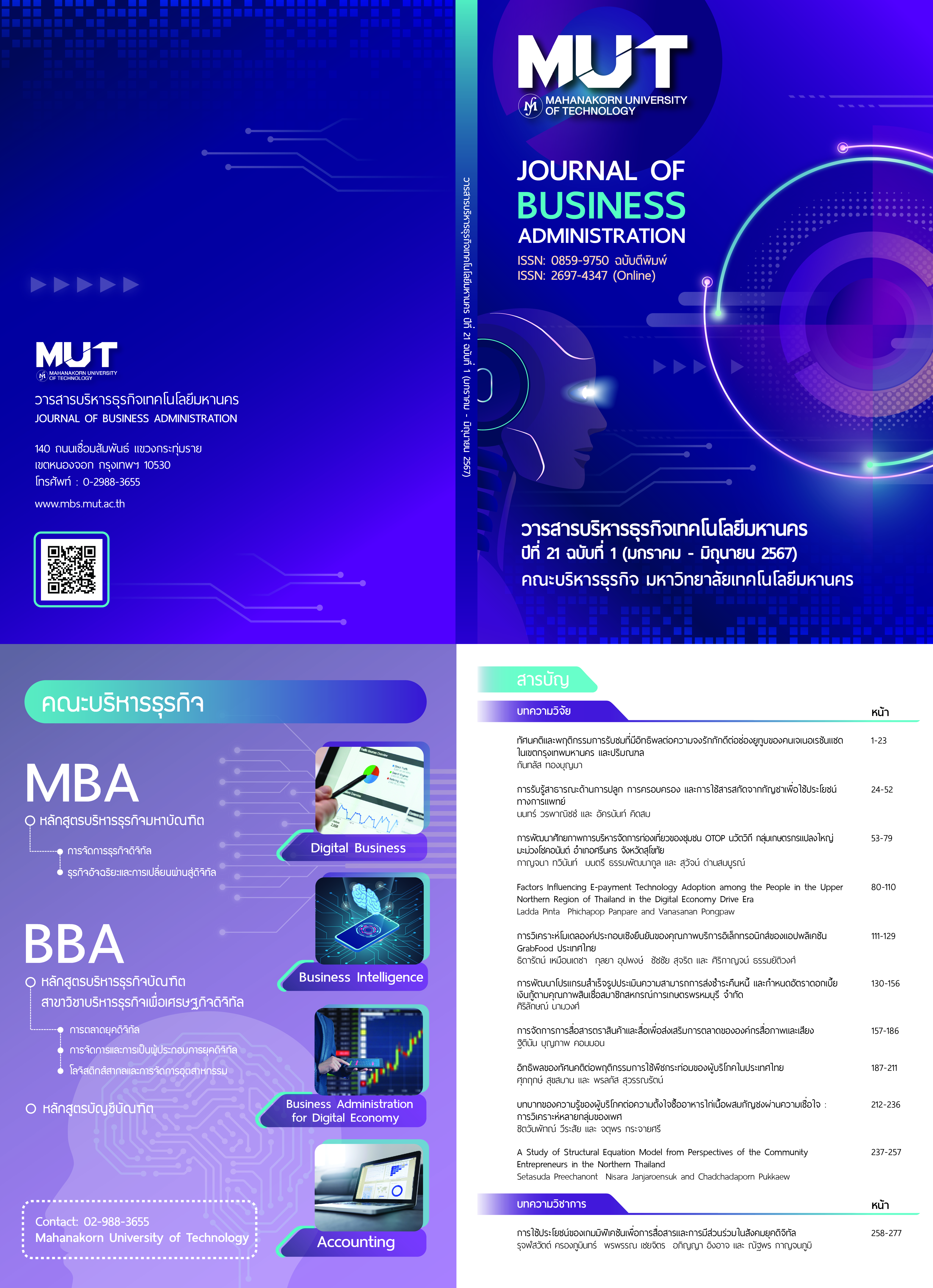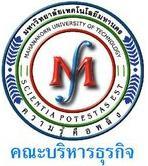Utilizing Gamification to Enhance Communication and Participation in the Digital Age Society
Keywords:
Gamification, Communication, Participation, Digital SocietyAbstract
This article “Utilizing Gamification to Enhance Communication and Participation in the Digital Age Society” tries to investigate the concept of gamification as the application of basic principles of game design and gameplay mechanics to be applied in a context that has different objectives in a way that is not directly playing the game. Its main aim is to increase engagement, interest, and be able to motivate players through various methods. The distinctive features and elements of gamification that were adapted for use in today's digital age society. Therefore, it leads to a review of literature related to gamification to see the use of gamification shows the importance and relationship of using gamification to communicate and create participation in today's society. This literature review found that the research has been published over 22 years (AD 2003 - 2024). It can be divided into 3 important areas: (1) educational technology, (2) marketing and business management and (3) creating social benefits. Using gamification for communication is another communication tool that helps create participation and results that are beneficial and appropriate for today's society. Moreover, it is also possible to create conditions for players to develop desired behavior according to their goals.
References
Aslam, W. and De Luna, I. R. 2021. The relationship between brand Facebook page characteristics, perceived value, and customer engagement behaviour: An application of Stimulus-Organism-Response (S-O-R). Revista Brasilerira de Gatao de Negocios. Vol. 23. No. 1. 43 – 62.
Banfield, J. and Wilkerson, B. 2014. Increasing student intrinsic motivation and self-efficacy through gamification pedagogy. Contemporary Issues in Education Research. Vol. 7. No. 4.
Chamnongplee, P. 2020. Factors influencing exercise monitoring application use and effect result. Faculty of Commerce and Accountancy. Thammasat University.
Chou, Y. K. 2019. Actionable gamification. Vol. 501. Packt Publishing.
Deterding, S., Dixon, D., Khaled, R. and Nacke, L. 2011. From game design elements to
gamefulness: defininggamification. Proceedings of the 15th International Academic MindTrek Conference: Envisioning FutureMedia Environments (MindTrek ’11). New York.
Gartner. 2011. Gartner Says By 2015, More Than 50 Percent of Organizations That
Manage Innovation Processes Will Gamify Those Processes. Retrieved March 30, 2024 from http://www.gartner.com/newsroom/id/1629214
Good, C. V. and Merkel, W. R. 1973. Dictionary of education. McGraw-Hill.
Ingard, A. 2021. Trust as a mediator of perceived values and purchase intention via Facebook live-streaming. Journal of Media and Communication. Special Issue. 19 – 33.
Ingard, A., Kijjabuncha, B. and Taivatchayanuwatt, T. 2024. The Influence of Service Variety and Media Access on User Loyalty: A Case Study of the BiliBili Application and Perceived Value as a Mediator Variable. The 2nd Proceedings of Thai Media Fund Journal. 192 - 220.
Kapp, K. M., Lee, J. J. and Hammer, J. 2014. Gamification in Education: What, How Why
Bother?. Academic Exchange Quarterly. New York: Columbia University.
Kim, J. and Lennon, S. J. 2013. Effects of Reputation and Website Quality on Online Consumers’ Emotion, Perceived Risk and Purchase Intention. Journal of Research in Interactive Marketing. Vol. 7. 33 - 56.
Koivisto, J. and Hamari, J. 2019. The rise of motivational information systems: A review
of gamification research. International Journal of Information Management. Vol. 45. 191 - 210.
Kutalad, N. 2022. The Meseum and Gamification Reviewing a Trend of Gamification Using in Thai Museum for Game Design. Institute of Culture and Arts Journal. Vol. 23. No. 2. 32 - 43.
Lo, C. K. and Hew, K. F. 2020. A comparison of flipped learning with gamification, traditional learning, and online independent study: the effects on students’ mathematics achievement and cognitive engagement. Interactive Learning Environments. Vol. 28. No. 4.
Madsen, K.M. 2020. The Gamified Museum: A critical literature review and discussion of gamification in museums. Game scope: The potential for gamification in digital and analogue places.
Mano, P. 2019. The Impact of Digital Disruption to the Education. Journal of Industrial Education. Vol. 18. No. 1. 1 – 6.
McGrath, N. and Bayerlein, L. 2013. Engaging online students through the gamification of learning materials: The present and the future. ASCILITE-Australian Society for Computers in Learning in Tertiary Education Annual Conference. 573 - 577.
Mehrabian, A. and Russell, J. A. 1974. An Approach to Environmental Psychology. MIT Press.
Mingsiritham, K. 2021. Technology to Learning for Educational Research in Digital Transformation. Bangkok. O.S. Printing House.
Musikapala, M. and Worachat, K. 2020. Gamification as An Innovative Communication for Building Brand Royalty. The Proceeding of the 10th Academic Conference on Communication Research and Works. 288 - 300.
Nasirzadeh, E. and Fathian, M. 2020. Investigating the effect of gamification elements on
bank customers to personalize gamified systems. International Journal of
Human-Computer Studies. Vol. 143.
Park, H. J. and Bae, J. H. 2014. Study and research of gamification design. International Journal of Software Engineering and Its Applications. Vol. 8. No. 8. 19 - 28.
Phetwong, W., Akaramethanon, J. and Sawangsri, K. 2018. The Development of Applications to Promote Consume Vegetable safety with Gamification Concept. Faculty of Business Administration and Information Technology. Rajamangala University of Technology Suvarnabhumi.
Rodrigues, L. F., Costa, C. J. and Oliveira, A. 2016. Gamification: A framework for designing software in e-banking. Computers in Human behavior. Vol. 62. 620 – 634.
Robson, K., Plangger, K., Kietzmann, J. H., McCarthy, I. and Pitt, L. 2015. Is it all a game? Understanding the principles of gamification. Business horizons. Vol. 58. No. 4.
- 420.
Shafudin, M. Y., Chin, F. G. and Raihanatul, Z. M. 2018. Factors influencing use of monsoonsim business simulation by UTM undergraduate students. International Journal of Learning and Development. Vol. 8. No. 2.
Simões, J., Redondo, R., Vilas, A. and Aguiar, A. 2013. Proposta de modelo de referência para aplicação de gamification em ambientes de aprendizagem social. Proceedings of the VIII International Conference on ICT in Education. Braga. 1117 - 1128.
Squire, K. 2005. Changing the game: What happens when video games enter the classroom?.
Journal of online education. Vol. 1. No. 6.
Tlee Krit. 2024. Case Study Gamification in Industry. Retrieved Mar 29, 2024 from https://www.everydaymarketing.co/knowledge/case-study-gamification
Toongsuwan, T. and Disatapund, S. 2021. The Development of Game for Cultural Tourism by Using Gamification Concept: NAN Province. Journal of Fine and Applied Arts. Chulalongkorn University. Vol. 8. No. 2. 26 - 42.
Walther, B. K. 2003. Playing and Gaming: Reflections and Classifications.
The International Journal of Computer Game Research. Vol. 3. No. 1.
Wangsitthichok, M., Rattanawan, P. and Sheoychitra, P. 2019. The Building of relationships through loyalty programs TMB WOW that affect the behavior of collecting points and customer loyalty towards TMB Bank Public Company Limited. The 2nd National Conference on ICT. 30 - 41.
Downloads
Published
Issue
Section
License

This work is licensed under a Creative Commons Attribution-NonCommercial-NoDerivatives 4.0 International License.
ข้อความ ข้อคิดเห็น ข้อมูล เนื้อหา รูปภาพ แผนภูมิ แผนผัง เป็นต้น ที่ปรากฏและแสดงในบทความต่างๆ ในวารสารบริหารธุรกิจเทคโนโลยีมหานคร ถือเป็นความรับผิดชอบโดยตรงของผู้เขียนบทความนั้นๆ มิใช่เป็นความรับผิดชอบใดๆ ของวารสารบริหารธุรกิจเทคโนโลยีมหานคร และมหาวิทยาลัยเทคโนโลยีมหานคร
บทความที่ตีพิมพ์ในวารสารบริหารธุรกิจเทคโนโลยีมหานคร ถือเป็นลิขสิทธิ์เฉพาะของคณะบริหารธุรกิจ มหาวิทยาลัยเทคโนโลยีมหานคร หากบุคคลหรือหน่วยงานใดต้องการนำทั้งหมดหรือส่วนใดส่วนหนึ่งไปเผยแพร่ต่อหรือเพื่อกระทำการใดๆ จะต้องได้รับการอนุญาตเป็นลายลักษณ์อักษรจากคณะบริหารธุรกิจ มหาวิทยาลัยเทคโนโลยีมหานครก่อนเท่านั้น


